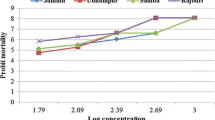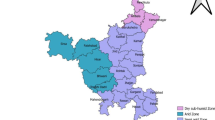Abstract
Field tick isolates of Rhipicephalus (Boophilus) microplus were collected from eleven districts located in the northern and eastern states of India to access the resistance status to “Amitraz”. Adult immersion test was optimized using laboratory reared acaricide susceptible IVRI-I line and minimum effective concentration was determined as 487.7 ppm with 95 % confidence interval of 455.8–521.8. The discriminating concentration was determined as 975.4 ppm and was tested on female ticks collected by two stage stratified sampling from organized dairy farms and villages. Based on three variables, viz., mortality, egg masses and reproductive index, the resistance level was categorized. Resistance to amitraz was detected at level I in 3 isolates (RF = 1.56–5.0), at level II in 6 isolates (RF = 9.3–23.3) and at level III in 1 isolate (RF = 27.3) whereas one isolate was found susceptible. The highest resistance was found in the SKR isolate (RF = 27.3) and minimal resistance was detected in the N-24P isolate (RF = 1.56). These experimental data will help in designing tick control strategy which is suffering from acaricide failure and to overcome development of resistance in ticks.

Similar content being viewed by others
References
Annual Report (2011–12) Department of Animal Husbandry, Dairying & Fisheries, Ministry of agriculture, Government, New Delhi, pp 36–48
Atkinson PW, Binnington KC, Roulston WJ (1974) High monoamine oxidase activity in the tick Boophilus microplus and inhibition by chlordimeform and related compounds. J Aust Entomol Soc 13:207–210
Baxter GD, Barker SC (1999) Isolation of a cDNA for an octopamine-like, G-protein coupled receptor from the cattle tick, Boophilus microplus. Insect Biochem Mol Biol 29:461–467
Benavides OE, Romero NA, Rodriguez JL, Silva ZJ (1999) Evidencia preliminar de la aparicion de resistenciaa lactonas macrociclicas en cepas de garrapata Boophilus microplus en Colombia. In: Memorias IV Seminarios Internacional de Parasitologia, Puerto Vallarta, Jalisco, Mexico 20–22: 266–264
Benavides OE, Rodriguez SC, Romero A (2000) Isolation and partial characterization of the Montecitos strain of Boophilus microplus (Canestrini) multi-resistant to different acaricides. Ann NY Acad Sci 916:668–671
Blenau W, Baumann A (2001) Molecular and pharmacological properties of insect biogenic amine receptors lessons from Drosophila melanogaster and Apis mellifera. New Zeal Arch Insect Biochem Physiol 48:13–38
Brito LG, Barbieri FS, Rodrigo B, Rocha MC, Oliveira S, Elisana S (2011) Evaluation of the efficacy of acaricides used to control the cattle tick, Rhipicephalus microplus, in dairy herds raised in the Brazilian southwestern amazon. Vet Med Int 201:2–13
Castro-Janer E, Rifran L, Piaggio J, Gil A, Miller RJ, Schumaker TTS (2009) In vitro tests to establish LC50 and discriminating concentrations for fipronil against Rhipicephalus (Boophilus) microplus (Acari: Ixodidae) and their characterization. Vet Parasitol 162:120–128
Curtis RJ (1985) Amitraz in the control of non-Ixodidae ectoparasites of livestock. Vet Parasitol 18:251–264
De Castro JJ (1997) Sustainable tick and tick-borne disease control in livestock improvement in developing countries. Vet Parasitol 71:77–97
Drummond RO, Ernst SE, Trevino JL, Gladney WJ, Graham OH (1973) Boophilus annulatus and Boophilus microplus: laboratory test of insecticides. J Econ Entomol 66:130–133
Ducornez S, Barré N, Miller RJ, Md Garine-Wichatitsky (2005) Diagnosis of amitraz resistance in Boophilus microplus in New Caledonia with the modified Larval Packet Test. Vet Parasitol 30:285–292
Dudai Y, Buxbaum J, Corfas G, Ofarim M (1987) Formamidines interact with Drosophila octopamine receptors, alter the flies behavior and reduce their learning ability. J Comp Physiol A161:739–746
Elfassy OJ, Goodman FW, Levy SA, Carter LL (2001) Efficacy of an amitraz-impregnated collar in preventing transmission of Borrelia burgdorferi by adult Ixodes scapularis to dogs. J Am Vet Med Assoc 219:185–189
Evans PD, Gee JD (1980) Action of formamidine pesticides on octopamine receptors. Nature 287:60–62
FAO (2004) Resistance management and integrated parasite control in ruminants: Guidelines, Animal Production and Health Division, pp 25–77
Finney DJ (1962) Probit analysis–A statistical treatment of the response curve. Cambridge University Press, Cambridge, pp 1–318
Floris I, Satta A, Garau VL, Melis M, Cabras P, Aloul N (2001) Effectiveness, persistance, and residue of amitraz plastic strips in the apiary control of Varroa destructor. Apidologie 32:577–585
Furlong J (1999) Diagnosis of the susceptibility of the cattle tick, Boophilus microplus to acaricides in Minas Gerais state, Brazil. In: Fragoso, HS, García, ZV (Eds.), IV Seminario Internacional de Parasitología Animal. Control de la resistencia en garrapatasy moscas de importancia veterinaria y enfermedades que trasmiten, CONASAG-INIFAP-INFARVET-IICA-AMPAVE-FILASA, Puerto Vallarta, Jalisco, Mexico pp 41–46
Garris GI, George JE (1985) Field evaluation of amitraz applied to cattle as sprays for control of Boophilus microplus (Acari: Ixodidae) in the eradication program in Puerto Rico. Prev Vet Med 3:363–369
Ghosh S, Bansal GC, Gupta SC, Ray DD, Khan MQ, Irshad H, Shahiduzzaman M, Seitzer U, Ahmed JS (2007) Status of tick distribution in Bangladesh, India and Pakistan. Parasitol Res 101:207–216
Grisi L, Massard CL, Moya Borja GE, Pereira JB (2002) Impacto econômico das principais ectoparasitoses em bovinos no Brasil. A Hora Vet 21:8–10
Jonsson NN, Hope M (2007) Progress in the epidemiology and diagnosis of amitraz resistance in the cattle tick Boophilus microplus. Vet Parasitol 146:193–198
Jonsson NN, Mayer DG, Green PE (2000) Possible risk factors on Queensland dairy farms for acaricide resistance in cattle tick (Boophilus microplus). Vet Parasitol 88:79–92
Jonsson NN, Miller RJ, Robertson JL (2007) Critical evaluation of the modified-adult immersion test with discriminating dose bioassay for Boophilus microplus using American and Australian isolates. Vet Parasitol 146:307–315
Kagaruki LK (1996) The efficacy of amitraz against cattle ticks in Tanzania. Onderstepoort J Vet Res 63:91–96
Kumar Rinesh, Paul S, Kumar S, Sharma AK, Gupta S, Rawat AKS, Chaudhuri P, Ray DD, Ghosh S (2011) Nucleotide specific changes in the hypervariable region of 16S rDNA gene as possible marker to differentiate the tick genera. Indian J Anim Sci 81:1204–1207
Kumar Rinesh, Nagar G, Sharma AK, Kumar S, Ray DD, Chaudhuri P, Ghosh S (2013) Survey of pyrethroids resistance in Indian isolates of Rhipicephalus (Boophilus) microplus: identification of C190A mutation in the domain II of the para-sodium channel gene. Acta Trop 125:237–245
Kumar S, Jayakumar K, Srinivasan MR, Udupa V, Ramesh N (2001) Biological efficacy of amitraz against the three host tick Rhipicephalus sanguineus. Indian J Anim Sci 71:527–528
Kumar S, Paul S, Sharma AK, Kumar R, Tewari SS, Chaudhuri P, Ray DD, Rawat AKS, Ghosh S (2011) Diazinon resistant status in Rhipicephalus (Boophilus) microplus collected from different agro-climatic zones of India. Vet Parasitol 181:274–281
Kunz SE, Kemp DH (1994) Insecticides and acaricides: resistance and environmental impacts. Rev Sci Tech Off Int Epizoot 13:1249–1286
Li AY, Davey RB, Miller RJ, George JE (2004) Detection and characterization of amitraz resistance in the southern cattle tick, Boophilus microplus (Acari: ixodidae). J Med Entomol 41:193–200
Mathivathani C, Abdul Basith S, Latha BR, Dhinakar Raj G (2011) In vitro evaluation of synthetic pyrethroid resistance in Rhipicephalus sanguineus ticks of Chennai. J Vet Parasitol 25:56–58
Miller RJ, Davey RB, George JE (2002) Modification of the Food and Agriculture Organisation larval packet test to measure amitraz susceptibility against Ixodidae. J Med Entomol 39:645–651
Minjauw B, Mc Leod A (2003) Tick borne disease and poverty. The impact of tick and tick borne disease on the livelihoods of small scale and marginal livestock in India and eastern and southern Africa. Research Report, DFID Animal Health Programme, Centre for Tropical Veterinary Medicine, University of Edinburgh, UK
Playford M, Rabiee AR, Lean IJ, Ritchie M (2005) Review of research needs for cattle tick control, Phases I and II. Meat & Livestock Australia Ltd, Sydney
Pound JM, Miller JA, George JE (2000) Efficacy of amitraz applied to white-tailed deer by the O4-posterolateral topical treatment device in controlling free-living long star ticks (Acari: Ixodidae). J Med Entomol 37:878–884
Rodríguez-Vivas RI, Mata-Mendez Y, Pérez-Gutierrez E, Wagner G (2004) The effect of management factors on the seroprevalence of Anaplasma marginale in Bos indicus cattle in the Mexican tropics. Trop Anim Health Prod 36:135–143
Sangwan AK, Chhabra MB, Singh S (1993) Acaricide resistance status of common livestock ticks of Haryana. Indian Vet J 70:20–24
Schuntner CA, Thompson PG (1976) Inhibition of a carbaryl oxidising enzyme as the primary lesion in the lethal action of formamidines in Boophilus microplus. J Aus Entomol Soc 15:388
Sharma AK, Kumar S, Tiwari SS, Srivastava S, Kumar Rinesh, Ray DD, Chaudhuri P, Rawat AKS, Ghosh S (2012a) Comparative acaricidal properties of different solvents and surfactants on Rhipicephalus (Boophilus) microplus (Acari: Ixodidae). Indian J Anim Sci 82:154–158
Sharma AK, Kumar Rinesh, Kumar S, Nagar G, Singh NK, Rawat SS, Dhakadd ML, Rawat AKS, Ray DD, Ghosh S (2012b) Deltamethrin and cypermethrin resistance status of Rhipicephalus (Boophilus) microplus collected from six agro-climatic regions of India. Vet Parasitol 188:337–345
Shaw RD (1966) Culture and organophosphorus resistant strain of B. microplus (Can.) and an assessment of its resistance spectrum. Bull Entomol Res 56:389–405
Shyma KP, Kumar S, Sharma AK, Ray DD, Ghosh S (2012) Acaricide resistance status in Indian isolates of Hyalomma anatolicum. Exp Appl Acarol 58:471–481
Singh NK, Gelot IS, Jyoti Singh V, Rath SS (2013) Detection of amitraz resistance in Rhipicephalus (Boophilus)microplus from North Gujarat, India. J Parasit Dis. doi:10.1007/s12639-013-0280-y
Soberanes MJ, Santamaria VM, Fragoso SH, Gracia ZV (2002) First case reported of amitraz resistance in the cattle tick Boohilus microplus in Mexico. Tec Pecu Mex 40:81–92
Strydom T, Peter R (1999) Acaricide and Boophilus spp. resistance in South Africa. In: Fragoso HS, García ZV (eds) IV Seminario Internacional de Parasitología Animal. Control de la resistencia en garrapatasy moscas de importancia veterinariay enfermedades que trasmiten, Conasag-Inifarvet-IICaampave-Filasa, Puerto Vallarta, Jalisco, Mexico, pp 35–40
Thullner F, Kemp DH, Mckenna RV, Willadsen P (2000) Dispersal test for the diagnosis of amitraz resistance in tick larvae (Boophilus microplus). In: Kazimirova M, Labuda M, Nuttall PA (eds) Proceedings of the 3rd international conference on ticks and tick-borne pathogens: into the 21st century. Institute of Zoology, Slovak Academy of Sciences, Bratislava, Slovakia, pp 205–208
Vatsya S, Yadav CL (2011) Evaluation of acaricide resistance mechanisms in field populations of Rhipicephalus (Boophilus) microplus collected from India. Int J Acarol 37:405–410
Veiga LP, Souza AP, Bellato V, Sartor AA, Nunes AP, Cardoso HM (2012) Resistance to cypermethrin and amitraz in Rhipicephalus (Boophilus) microplus on the Santa Catarina Plateau, Brazil. Rev Bras Parasitol Vet 21:133–136
Whalon ME, Mota-Sanchez D, Hollingworth RM (2008) Global pesticide resistance in arthropods. CAB Int, 381, Cromwell Press Trowbridge, UK
Acknowledgments
The authors are grateful to Indian Council of Agricultural Research, New Delhi for funding through World Bank funded National Agricultural Innovation Project No. NAIP/Comp-4/C2066/2008-09. Authors are also grateful to the Veterinary officers posted at different tick collection spots for their support.
Author information
Authors and Affiliations
Corresponding author
Rights and permissions
About this article
Cite this article
Kumar, S., Sharma, A.K., Ray, D.D. et al. Determination of discriminating dose and evaluation of amitraz resistance status in different field isolates of Rhipicephalus (Boophilus) microplus in India. Exp Appl Acarol 63, 413–422 (2014). https://doi.org/10.1007/s10493-014-9789-8
Received:
Accepted:
Published:
Issue Date:
DOI: https://doi.org/10.1007/s10493-014-9789-8




